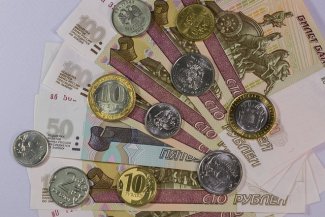Russia: export restrictions and mobilisation – more blows to the economy

In Q3 2022, the economy of the Russian Federation increasingly suffered negative consequences from the sanctions imposed on Russian exports. A ban on imports of a substantial part of Russian steel and iron into the EU came into force in mid-June, followed by a ban on imports such as cement and wood on 10 July, and a ban on coal imports on 10 August. The mood among business and the public soured further with the military mobilisation announced on 21 September, which also had a negative impact on the domestic outlook. As a result, the Russian budget is coming under increasing strain.
According to Rosstat’s preliminary estimates, Russia’s GDP contracted by 4% year-on-year in Q3, with the decline deepening in September, driven by falling domestic demand and export revenues. The lower economic activity was the result of increased uncertainty about further developments in the context of rising geopolitical tensions and the ongoing mobilisation. According to current forecasts, the economy of the Russian Federation may contract as a whole by between 3% (domestic assessments) and 6% (international assessments) in 2022. The de facto scale of the economic crisis in Russia will depend on how its oil sector reacts to the introduction of an EU embargo on Russian oil imports on 5 December, and also to the plans by the G7 countries and Australia to impose a price cap on exports of this oil by sea to third countries. Source: Rosstat, rosstat.gov.ru.
Domestic demand remains low. Retail trade fell by more than 9% in Q3, with the trend worsening in September, largely due to the announced mobilisation. Anxious about the future, the public further reduced spending, especially on manufactured goods. Sales of these fell by 15% year-on-year in September, while agri-food trade turnover declined by 3.5%. Source: Rosstat, rosstat.gov.ru.
Persistently low domestic demand has stalled price growth in Russia, with annual inflation running at 12.6% in October. Prices peaked in May and have been declining since then. This was particularly evident in foodstuffs, and was related to such factors as seasonality and access to this year’s agricultural crops. Prices of manufactured goods, especially those imported or made using parts from abroad, were significantly higher: for example, household chemicals were over 30% more expensive year-on-year in October, while electronic goods and household appliances were over 17% more expensive. On the other hand, inflation has so far been held back by service costs. In this segment, the prices of utilities, housing and transport are the most significant: the Russian government has tried to keep their growth in check, but increases in most tariffs have already been announced for December. Source: Rosstat, rosstat.gov.ru.
Industrial production shrank in Q3 by 3.1% year-on-year: this was mainly driven by the processing sector, although declines in the extraction sector also began to appear. At the same time, growth was recorded in construction (up by almost 7% y-o-y) and agriculture (up by more than 6%). As of 1 October, over 140 million tonnes of cereals were harvested, more than 30% up on a year ago. Production of food and beverages (mainly alcohol) also increased. The arms sector grew as well (its GDP share was estimated at around 3%, compared to 4% for agriculture), although this is not reported separately in the statistics. For example, the twelve plants of this sector located in Udmurtia (one of the republics that make up the Russian Federation) increased production in H1 by 28% year-on-year, according to data from the regional authorities. Source: Rosstat, rosstat.gov.ru.
Particularly large decreases were recorded by the industries affected by Western restrictions. In September, wood processing was down by almost 20%, with the western Russian regions (mainly Karelia) which export their production to Europe suffering the most, while Siberian producers continued to find buyers in China. Following the withdrawal of Western companies, production of passenger cars plummeted (down by 77% in September from a year earlier), as was also true of refrigerators and dishwashers (down by around 50%). Freight transport (in tonne-kilometres) also declined, by a total of around 7% year-on-year.
There has been no decline in oil production so far. In September, as in the first nine months of 2022, it remained slightly higher than a year ago. According to data from the International Energy Agency, oil exports totalled 7.5 million barrels per day in September, about 0.5 million barrels less than in the months preceding the war (down by about 7%). As the embargo looms, the EU’s share among Russian crude customers has already fallen, to 35% in September, down from 50% at the beginning of the year. At the same time, there are growing difficulties with identifying who the recipients of more and more Russian exports actually are, indicating that Russian companies are already devising schemes to circumvent sanctions.
However, the gas sector is suffering from far more serious problems, as it has suffered not from Western restrictions but from the Russian counter-sanctions (gas blackmail against the EU). As a result, Gazprom’s production declined by more than 30% year-on-year in October and by more than 35% year-on-year in the entire Q3, while exports to the so-called countries ‘further abroad’, which in Russian terminology includes European customers except the Baltic republics and also encompasses Turkey and China, declined by 67% year-on-year in October and by more than 60% in the whole of Q3. So far, however, the high prices are largely able to compensate for the losses resulting from the drop in supply volumes. In the first nine months of the year, the turnover of oil and gas operators (Rosstat does not provide separate data for the gas sector) was over 30% higher y-o-y, although it fell by 12% y-o-y in the month of September.
Total coal production fell by less than 2% year-on-year in the first three quarters of the year. However, the production of certain types of coal, especially anthracite, declined much more rapidly. Export problems were partly offset by an increase in domestic demand due to a fall in hydroelectric power generation as a result of low water levels in Siberian rivers. Coal exports were down by 9% in the first nine months of the year, with a decline of around 19% in exports to Western countries. Although Russia has been redirecting some exports to Asian markets (mainly China and India) since May, the profitability of these shipments has fallen due to high logistical costs and the huge discounts offered to customers, sometimes up to 60–70% on European coal prices. As a result, shipments to China fell by 18% and to India by 12% in September compared to the volumes a month earlier. Company turnover in the coal industry was down by more than 25% year-on-year in September. Overall, however, in the first nine months of the year, it surged by 65% compared to the same period in 2021 thanks to high commodity prices.
Iron ore production decreased by more than 9% year-on-year in September, and steel production by almost 10%. The problems of the metallurgy sector have not only been caused by the sanctions, but also by the policy of the Russian government, which last year increased the tax burden on the sector in view of the high profits it generated in 2021. In the case of steel, as with other raw materials, logistics are a major constraint on the reorientation of exports to Asian markets, as the Trans-Siberian railway has basically already reached maximum capacity. In addition, the Russian government arbitrarily allocates transport tariff subsidies to individual regions, economic sectors and companies. Source: Rosstat, rosstat.gov.ru.
Data from the Central Bank of Russia (CBR) shows that the value of Russian exports of goods and services (the CBR publishes only aggregate data) dropped in Q3 by around 6% compared to the previous quarter. However, these indicators are still significantly higher than a year ago, which is related to the increase in prices of raw materials sold by Russia, especially oil, which is the basis of Russian exports. Meanwhile, imports rose by more than 18% compared to the previous quarter’s results, although they are still significantly lower than a year ago. According to mirrored statistics from Russia’s trading partners, since July the value of Chinese sales to the Russian Federation has been higher than a year ago (in September by more than 17%), while Turkey has been reporting increased exports to Russia since March (in September they were twice as high as last year). There is no information, however, on what impact the commodity prices or volumes have had on the increased value of deliveries to the Russian Federation. In the case of European Union countries, exports to Russia have also been growing in recent months, but are still much lower than a year ago (in September by more than 45% y-o-y, while in April the decline was over 60% y-o-y).
The decreasing exports and increasing imports have resulted in a declining current account surplus, and also allowed the rouble’s exchange rate to weaken. Source: Rosstat, rosstat.gov.ru.
Foreign trade performance has a strong impact on public finances. Revenues from the oil and gas sector have been shrinking since April, and monthly receipts from the sector since July are already lower than a year ago (by 4% y-o-y in September). Nevertheless, the surpluses generated in the first half of the year meant that in the first nine months of this year, revenues from this sector were 25% higher than for the same period last year. These revenues grew again in October, but this was connected with an increase in the tax burden imposed on the sector. The situation is much more difficult with regard to receipts coming from the other segments of the economy. After nine months of the year, they were 4% lower y-o-y, largely due to a decline in receipts from imports of goods into the Russian Federation (customs, VAT and excise duties).
In order to balance the budget, the government has decided to introduce a higher tax burden on the energy sector during the fiscal year. First of all, an additional extraction tax has been imposed on Gazprom. This will cost the company more than 1.2 trillion roubles in 2022, i.e. the equivalent of 1% of the Russian Federation’s GDP (the company was de facto deprived of its 2021 profit, which was supposed to be allocated to dividends for shareholders). These funds will go to the state budget in three equal instalments between October and December this year. Also, the number of oil and gas fields where corporations pay tax on additional production revenues has been increased. Moreover, the government also reduced compensation for oil companies supplying petroleum products to the domestic market when global market prices are high, the so-called reverse excise tax.
Russia’s budget spending in the first nine months of the year rose by more than 20% year-on-year. As the publication of some data has been withheld, very little is known about the structure of this spending. However, the introduction to the Russian Federation’s draft budget for 2023–5 prepared by the ministry of finance shows that spending on national defence is set to increase the most in 2022 (by more than 30%), followed by internal security (by more than 20%). Spending on social policy will only increase by the amount of inflation (around 12%).
As a result, this year’s federal budget is expected to be implemented with a deficit of around 1% of GDP (around 1.3 trillion roubles), which will be financed by increasing internal debt. In recent weeks, the government has already issued several tranches of bonds, most of which have been purchased by state-owned banks. But despite the high interest rates, there is little investor interest in them. Therefore, the authorities have already had to draw on reserves accumulated in the National Welfare Fund. Source: Ministry of Finance of the Russian Federation, minfin.ru.
In 2023, the Russian government plans to further increase spending, especially on internal security and national defence. In total, the government intends to allocate more than 32% of the budget to these purposes (compared to around 28% in 2022 and 24% in 2021). With revenues on the decline, this will increase the deficit to 2% of GDP (around 3 trillion roubles). It will be necessary to further tap into the reserves accumulated in the National Wealth Fund. In October this year, the liquid assets of this fund totalled 7.5 trillion roubles, although most of these reserves have been frozen by Western countries, as they were placed in Western currencies and held in CBR accounts. However, the government is still able to tap into them through accounting operations, as it collects funds in roubles from the central bank. Inflationary pressures are de facto increasing in Russia. Pursuant to a government decision, a rule that allowed additional revenues from exports of energy resources to be accumulated in the Fund was abandoned in 2022, and these are now used entirely for the needs of the current budget.
The Russian Federation’s Ministry of Finance had prepared draft budgets for the next few years before the announcement of the mobilisation and the further escalation of aggression against Ukraine. Hence, we can expect an increase in war-related expenditure and funding of the repressive apparatus: the ministry is already preparing amendments to the document. The budget does not set any limits on the Russian government’s activities, and the government readily changes its parameters to suit the Kremlin’s current needs. For example no official amendments to the 2022 budget law, signed by the president in December 2021, have so far been made, although its implementation has differed significantly from what was written in the document. Source: Ministry of Finance of the Russian Federation, minfin.ru.
The crisis situation in the Russian economy is increasingly being felt by the public. Officially, real incomes fell by less than 2% in the nine months of 2022, but the rate of decline accelerated in Q3. Meanwhile, a drop of around 10% in the value of retail trade demonstrates the real decline in citizens’ living standards. The state is trying to support only the poorest: to this end, pensions have been index-linked and additional aid has been given to families with children. The incomes of working people are dropping. Although state-owned companies and big business are maintaining employment levels, they are compensating for their losses due to overstaffing by reducing wages and working hours. As a result, unemployment remains very low (3.9% in September). However, a survey conducted by the Institute of Social Sciences of the Academy of National Economy under the President of the Russian Federation found that around 33% of workers were supplementing their salaries in October (compared to May, this percentage has increased, although it was not said by how much). In turn, information collected by the job placement service HeadHunter shows that only 22% of Russians were able to finance their needs from salaries in June, while for 39% it was not enough and 38% of respondents said they were struggling to make ends meet. Labourers, healthcare workers and others employed in the so-called budget sector, especially teachers, were the worst off.
In addition, the mobilisation and a mass outflow of the best-educated and most active people are severely disrupting the labour market. Many industries are experiencing shortages of applicants for various positions, for example construction, agriculture and the IT sector. However, due to the ongoing technological regression of the economy, the effective demand for manual workers is increasing, while so-called white collar workers are struggling to find employment. Demography was already a principal factor negatively affecting the economic growth of the Russian Federation before the invasion of Ukraine, and the war has only exacerbated the problem. Nonetheless, Russia will primarily feel the consequences related to the state of its human capital in the long term. Source: Rosstat, rosstat.gov.ru.
All statistical data from the Russian Statistical Office (Rosstat, rosstat.gov.ru), unless stated otherwise in the text.




